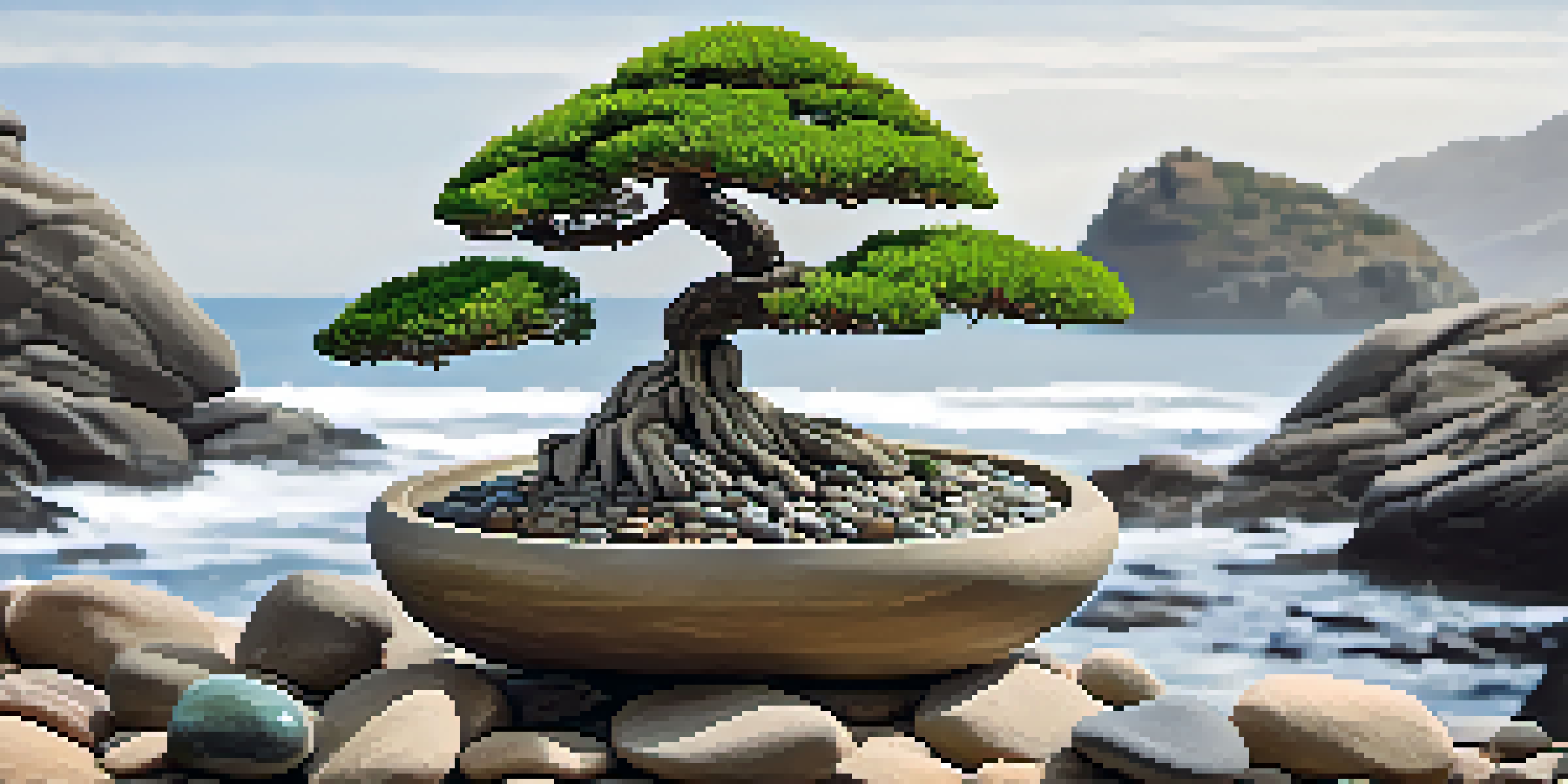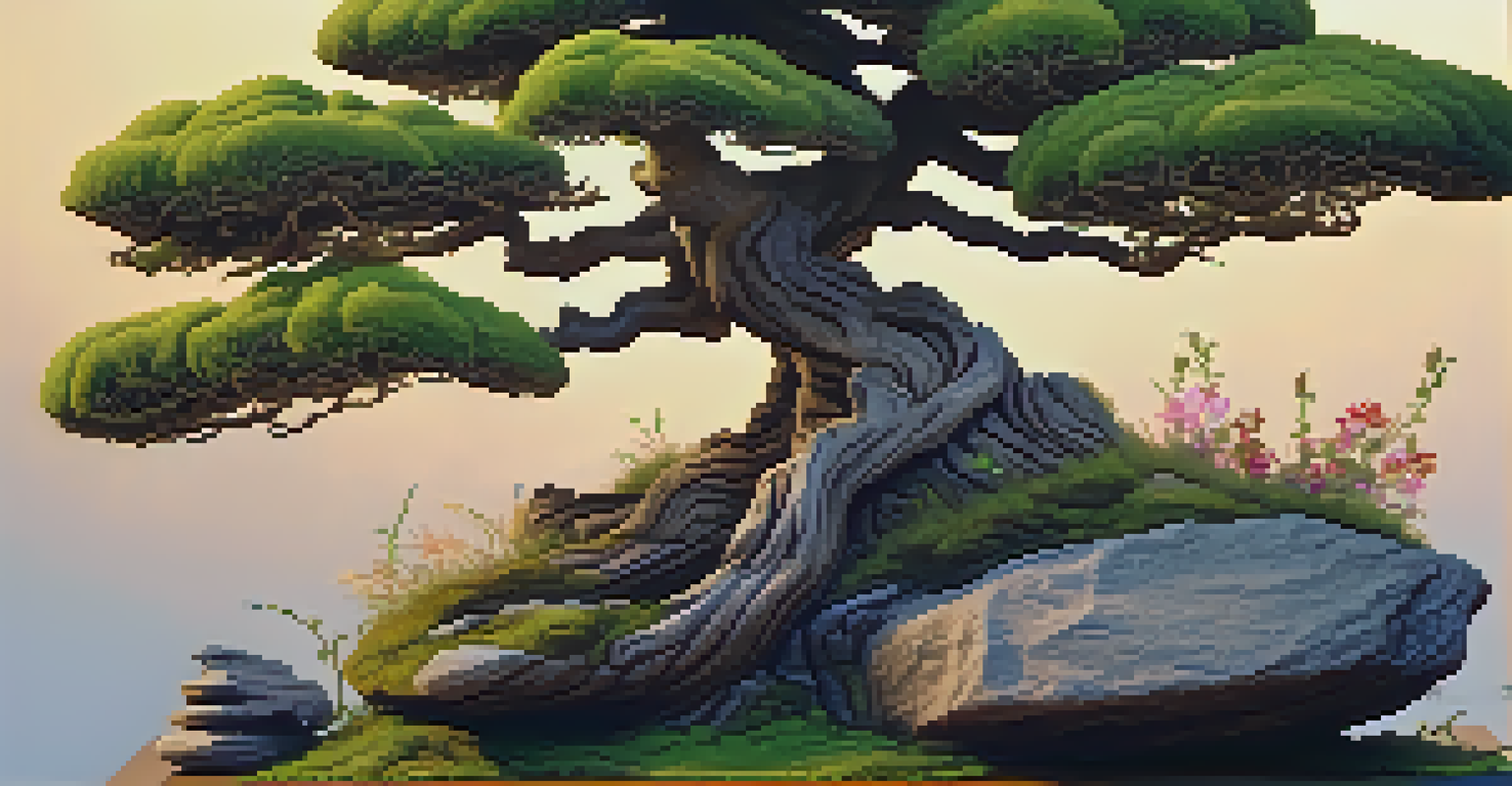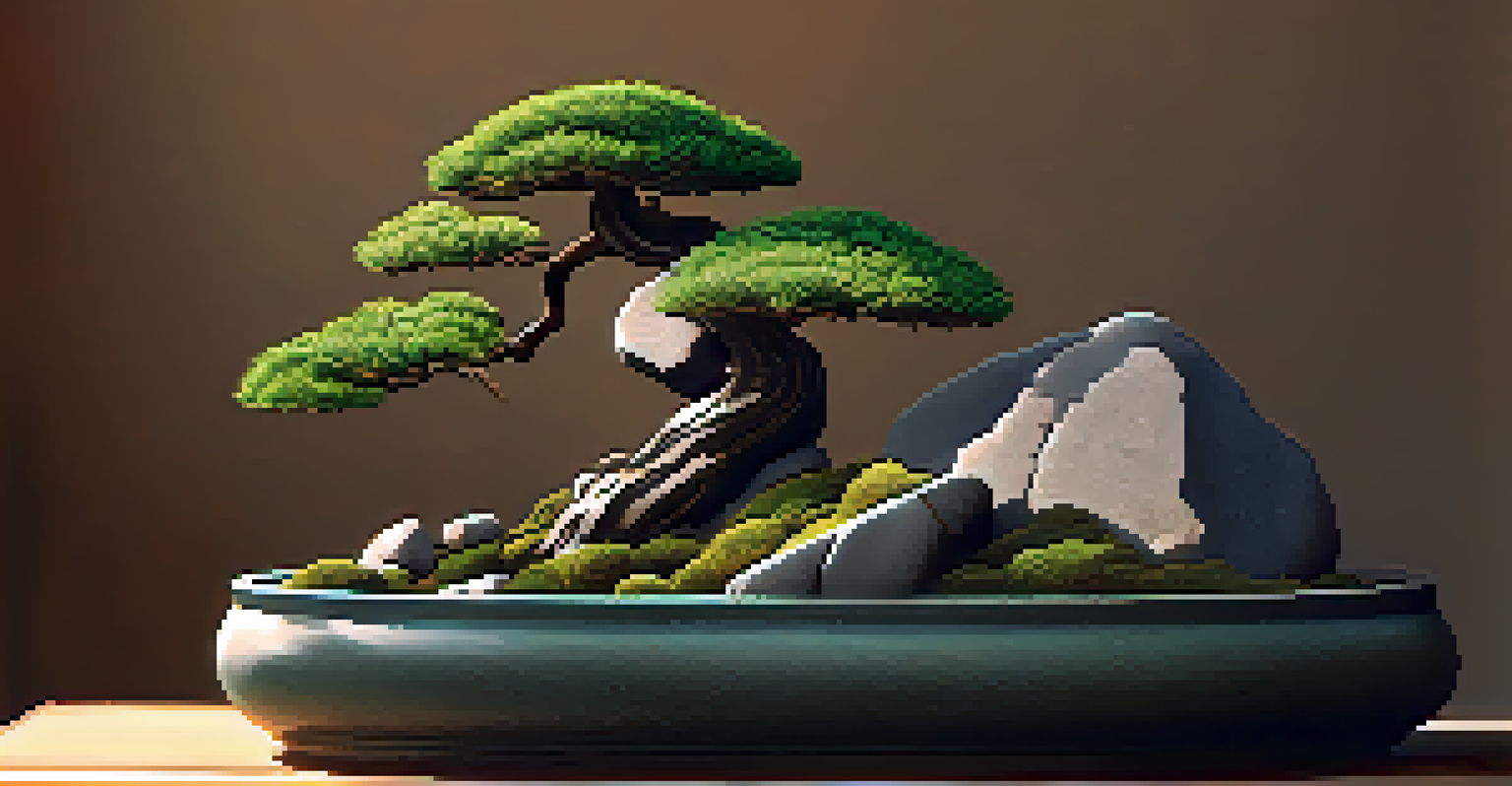Using Rocks and Stones in Bonsai: Creating Natural Scenes

The Importance of Rocks and Stones in Bonsai Design
Rocks and stones play a crucial role in bonsai design, providing a natural aesthetic that enhances the overall composition. They can symbolize strength, permanence, and the beauty of nature, offering context for the tiny trees we cultivate. In many traditional Japanese gardens, rocks are not just accessories but integral components that help dictate the landscape's story.
The creation of a bonsai is a reflection of the artist's spirit, and the rocks serve as a silent yet powerful partner in that expression.
When used thoughtfully, these natural elements can help create a sense of scale, making the bonsai appear more lifelike and grounded. For example, a large rock can represent a mountain, while smaller stones can mimic a riverbed or beach. This not only adds depth to the design but also invites the viewer to appreciate the intricate relationships between the elements.
Moreover, incorporating rocks can enhance the health of the bonsai by providing drainage and stability to the soil. They can help prevent waterlogging, which is essential for the roots' health, ultimately leading to a thriving bonsai. Thus, rocks are much more than mere decorations—they are vital to the ecosystem within your bonsai pot.
Choosing the Right Rocks for Your Bonsai
Selecting the right type of rock is essential for creating a harmonious bonsai scene. Different stones vary in texture, color, and size, affecting how they complement the tree. For instance, smooth pebbles might convey a gentle riverbank, while rugged boulders can evoke the majesty of mountains, allowing you to tailor the scene to your vision.

Consider the scale of your bonsai when choosing rocks. A small tree may get lost next to a massive stone, while a larger tree might look unbalanced with tiny pebbles. Aim for a proportionate relationship that enhances the overall aesthetic without overshadowing the bonsai itself.
Rocks Enhance Bonsai Aesthetics
Incorporating rocks into bonsai design adds a natural aesthetic and context that complements the miniature trees.
Furthermore, think about the colors and patterns of the rocks you select. Earthy tones often work well with green foliage, creating a cohesive look. However, don't shy away from contrasting colors that can add visual interest, just like how a splash of color in a painting can draw the eye.
Techniques for Arranging Rocks in Bonsai
Arranging rocks in your bonsai display requires creativity and a bit of planning. Start by visualizing the scene you want to create and how the rocks will interact with the bonsai. You might lay out the stones on a flat surface before planting, allowing you to play with different configurations until something feels right.
A rock is a symbol of stability and strength, mirroring the journey of growth and resilience found in bonsai.
One popular technique is to group rocks in odd numbers, as this often creates a more natural look. For example, placing three stones of varying heights together can mimic a natural outcropping. Additionally, consider the orientation of the rocks; angling them slightly can add dynamism, making the scene feel more alive.
Don't forget to account for the bonsai's growth when arranging your rocks. As your tree matures, it will change shape and size, so leave enough space around it for future expansion. This foresight will help maintain balance in your design over time, ensuring that it evolves beautifully.
Creating a Sense of Depth with Rocks
To create a compelling bonsai scene, it's essential to establish a sense of depth. This can be achieved by layering rocks in the arrangement, placing larger stones towards the back and smaller ones in front. This technique draws the viewer's eye into the composition, creating an illusion of a three-dimensional landscape.
Additionally, consider varying the heights of the rocks. By stacking or angling stones, you can lead the viewer's gaze upward, mimicking natural terrains like hills or cliffs. This verticality not only enhances the scene's depth but also emphasizes the bonsai's unique features.
Choosing Rocks for Balance
Selecting the right size, color, and texture of rocks is crucial for creating a harmonious and proportionate bonsai scene.
Don't hesitate to incorporate ground cover such as moss or small plants around the rocks. This greenery can soften the transition between the stones and the bonsai, creating a seamless blend that mimics the natural world. The result is a harmonious scene that feels both tranquil and alive.
Using Rocks to Enhance the Bonsai's Story
Every bonsai has a story, and rocks can help articulate that narrative. For instance, if you're aiming for a coastal theme, you might choose smooth, rounded stones that evoke a beach. Alternatively, sharp-edged rocks could reflect a mountain landscape, adding an adventurous element to your design.
Think about the symbolism associated with different rocks as well. In Japanese culture, certain stones are believed to bring good fortune or represent specific virtues. Incorporating these elements can add layers of meaning to your bonsai, making it not just a visual delight but also a source of inspiration and reflection.
Sharing the story behind your design can also deepen your connection with others. Whether you’re showing off your bonsai to friends or sharing it online, explaining the significance of the rocks and how they relate to the tree can spark meaningful conversations. This storytelling aspect is what makes bonsai truly captivating.
Maintenance of Rocks in Bonsai Arrangements
Maintaining the rocks in your bonsai arrangement is just as important as the initial setup. Over time, soil can shift, and rocks may need readjusting to keep the composition looking its best. Regularly check the arrangement to ensure everything remains stable and visually appealing.
Additionally, be mindful of any moss or plants that may grow around the rocks. While they can enhance the natural look, they might also cover the stones or even obstruct the bonsai's growth. A gentle trim or repositioning can help maintain that delicate balance between the tree and its rocky companions.
Rocks Tell a Bonsai's Story
Rocks can symbolize different themes and narratives in bonsai arrangements, enriching the overall meaning and connection to nature.
Cleaning the rocks is also essential for preserving their beauty. Dust and debris can accumulate over time, detracting from the overall aesthetic. A simple rinse with water or a soft brush can refresh their appearance, ensuring they continue to complement the bonsai beautifully.
Finding Inspiration for Your Bonsai Rock Designs
Inspiration for using rocks in bonsai can come from various sources, both natural and artistic. Take a stroll through a local garden or park, observing how rocks are integrated into landscapes. This real-world experience can spark ideas on how to arrange your own stones to create a desired effect.
Books and online resources about bonsai and Japanese gardens can also provide valuable insights. Look for photographs and tutorials that showcase different styles and arrangements. They often highlight innovative ways to use rocks, revealing techniques you might not have considered.

Lastly, don't forget to engage with the bonsai community. Online forums, social media groups, and local clubs are great places to share your work and get feedback. Seeing how others incorporate rocks into their designs can inspire you to experiment with your own creations, pushing the boundaries of your bonsai artistry.